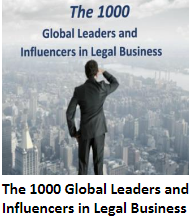Stephen J. McGarry Founder, AILFN , Lex Mundi, WSG, & HG.org
Stephen McGarry, B.A., M.A., J.D., and LL.M. (Taxation), founded World Services Group (WSG), a multidisciplinary network, in 2002. As president, he grew it to 150 firms that have 21,000 professionals in 600 offices in more than 100 countries. In 1989 McGarry founded Lex Mundi, the world’s largest law firm network. As president, he grew it to 160 law firms that today have 21,000 attorneys in 600 offices in 100-plus countries. These two networks represent 2 percent of all the lawyers on earth. In 1995, he founded HG.org, one of the first legal websites. Today, it is among the world’s largest sites with more than five million pages and 900,000 users each month who download almost two million pages. McGarry is admitted by exam to the bars of Minnesota, Texas, and Louisiana. In 2002, American Lawyer Media (ALM) published McGarry’s treatise on Multidisciplinary Practices. McGarry has authored numerous articles on associations and international business transactions.
Introduction
All businesses comprise a pool of financial and human
capital that creates a product or performs a service. This capital can be configured
in an unlimited number of ways to achieve specific objectives for the service
provider or manufacturer. With professional services, objectives are achieved
via a controlled entity, such as an accounting or law firm, and membership in
an association of independent service providers. These associations are
commonly referred to as professional services networks or associations.
Law firm organizations are defined by elements of purpose,
structure, and process.[1] The purpose
of a network is different from that of a company or professional firm in that
it is limited to specific activities that will benefit its members and enhance
its performance. Within the network, they can operate to pursue their
interests. These interests can include referrals, joint venturing, access to
expertise, developing regional expertise, publishing articles for clients,
branding, technical information exchange, market positioning, pro bono
services, and more.
Beyond the objective of a law firm network is the need to
create a framework with the potential to allow the members to expand their
services. The network’s structure reflects the activities it seeks to promote
and the underlying cultures of the members. The scope of these interests is
defined not by the members, but by the network. Therefore, each network must be
different.
One of the major factors influencing the need for networks
is the globalization of the economy. Supply and demand are no longer local. The
price of commodities is affected by a number of uncontrollable factors such as
the weather halfway across the world or by demand in developing countries. In a
market where production takes place wherever utilization of assets and human
resources occur most effectively, professional services providers need to
represent their clients globally. Networks are the only practical method to
accomplish these objectives.
A network is more than a support organization or
collaborative framework in which the members can meet clients’ needs. It is an
entity entrusted with a common corporate identity. Though the network and not
the members own the logo and brand, the network name can establish and
represent a standard required of all its members. Consequently, membership in
the network creates a global corporate identity. The goal of this identity is
network participation that will ultimately translate into business for the
individual independent members.
From a theoretical point of view, networks are an effective model and a powerful system of enhancing services. The members and the networks are different parts of the resource equation for providing members seamless and high-quality local and global services. There is no real limit to what can be accomplished through a network when the network and its membership work together. This collaboration is at the heart of the network.
Why Do Firms Join?
When asked why they joined, members usually state tangible
reasons: to receive referrals from other members; to have reliable firms to
which they can refer; to maintain independence; to meet clients’ needs; to
retain existing clients by being able to provide services in other states or
countries; and to use the membership to obtain new clients in their market.
They also join for intangible reasons. In today’s world,
change is both constant and accelerating. Therefore, having access to other
members can be important. A network helps to reduce the degree of uncertainty
by bringing together a greater number of specialized resources to work on a
problem. In addition to facilitating the exchange of knowledge that can reduce
risks in firm operations, network memberships also reduce possible loss through
burden sharing. Membership is a proactive way to profit from change and, at the
same time, conserve resources. Membership can enhance the prestige of the
member by being associated with prestigious firms that the client already uses.
Networks achieve these objectives in a way that is very different from corporate structures in which executives have command and control. Networks emphasize reputations, commitments, and trust of each member.[2] In networks, there is collaboration between members and the network’s staff. Personal motivations move the network development forward.[3] However, personal motivations can also impede forward momentum.
Law Firm Networks – History
There were two distinct and different reasons for networks
developing in the legal profession. The first was internationalization, which
became globalization.[4] Law firms
simply needed international connections. The second was the expansion of a
number of large United States firms who pushed to become “national.” Smaller
firms or firms with a niche practice required this same expertise in other
states.
Internationalization of the legal profession began much later than in accounting firms.[5] There was no real need because, unlike the accounting firms that conducted worldwide audits, law firms in each country were equipped to deal with client matters. This changed in 1949 when Baker McKenzie began to expand to non-United States markets to assist U.S. clients trying to expand overseas following WWII.[6] The first step was establishing correspondent relationships with firms outside of the United States. This was necessary in that many countries would not permit a law firm to operate without a local name.[7]
The Need for Global Networks[8]
Internationalization was slow to start because the legal
profession was much more restrictive than accounting in allowing foreign firms to
enter and practice in their countries. There were rules requiring that the
names of the partners be present in the name of the firm. As a firm expanded,
it began to use its name when possible in as many countries as commercially
feasible. The purpose was the same as in accounting: establish a brand and
attract clients to it. The downsides were that the legal profession looked down
at the Baker McKenzie model and its own competition pejoratively characterized
Baker McKenzie as a franchise.[9] The forces of
the international community converged in the late 1980s. American and English
firms began establishing branches in the primary commercial centers. This niche
competition in local markets had the immediate effect of forcing local firms to
evaluate alternative ways of providing services to their international clients.
Law firms, like the accounting firms, were looking for
niche markets. The difference was that U.S. law firms focused internationally
on a niche market. In the 1970s, niche markets focused on serving financial
services and then branched out to clients in manufacturing.[10] The result
today is that more than 100 United States law firms have offices outside of the
country.[11] However, the
reality is that internationalization is very limited among U.S. law firms —
among the largest 100, the average has five overseas offices.[12]
The New York and London firms that opened offices at first
generally did not practice local law, so the regional firms were protected and
received referrals on local matters. This also changed as the number of
branches increased and the firms indigenized. With the advent of legal
advertising, U.S. firms gained the opportunity to market their services in the
U.S. and, as a result, indirectly began to market themselves in each of the countries
where they had offices. Local bars to which attorneys received their licenses
had severe restriction on their own firms that were not lifted until very much
later.[13] For example,
local partners and associates were required to be citizens and to be admitted
to the bar where they practiced. Naturally, when foreign firms began to meet
these criteria, local firms became concerned. The result was a need for local
firms to band together, and networks became tools to compete against the much
larger intruders to address this expansion. In fact, the first network of local
firms came about primarily as a result of the invasion by London and New York
firms.
Networks can be evaluated at different by the level of
organization and activities pursued by the network. There are four levels. In
the legal profession, there are no Level 4 networks unless you count the large
international firms now organized as Swiss vereins as networks. A case can be
made for this development.
Level 1 international networks, called clubs,
generally consist of 10 firms in different countries.[14] The typical
format consists of holding several meetings a year among managing partners to
discuss management and market-related issues. Secrecy shrouded the networks
because the members feared losing business from other firms if they knew of
these networks.[15] On the other
hand, many did not hesitate to advertise to their clients that they had foreign
connections and correspondents. Today the clubs are commonly known as “best
friend’s networks.” Examples include Leading Counsel Network[16] and Slaughter
and May.[17]
Level 2 networks began in the 1980s when the Level 1 clubs
evolved into networks. By that time, networks were not as secretive and even
published directories, materials, and brochures.[18] The members
met annually, and some networks focused on specific practices, such as
litigation,[19] while others
were more generic. Because networks were not thought of as franchises or
strategic models, the membership selection process was not particularly rigorous.[20] Many of the
networks that were innovators in the 1980s reached Level 2 and had no intent to
develop beyond this level. This is evidenced by the fact that their membership
over several decades has not increased, their websites contain no information,
their governance depends on the same individuals, and their operations are
limited.
Level 3 networks began in 1989 when Lex Mundi was formed.[21] It was the
first network that required each member to be one of the largest and most
established firms in a state or country. Unlike a Level 2 network where all
activities are internal, 50 percent of its activities were external.[22] The list of
internal and external activities reflected approximately 30 different items.
Another difference existed in Lex Mundi’s operations: It was a network
organized around a home office with staff, rather than a staff being assembled
after the network was established. Finally, Lex Mundi set itself apart by using
collaborative efforts among its personnel, board, councils, and members to achieve
the objectives. In essence, Lex Mundi operated as a business that provided
members with many alternatives to expand their resources. While different from
the accounting network, the concept was that of an entity which provided
services to members and should also have an established brand.
Other networks like TerraLex[23] and Meritas[24] soon followed
with a similar business-based model. Their stated objective was to create a
branded alternative to the large United States and English law firms that had
expanded into their countries. These networks were not secret, and all of them
have many of the features of Level 3 networks.
U.S. national networks also joined the revolution. The
first was the American Law Firm Association, a network that focused primarily
on insurance litigation.[25] The second
was the State Capital Law Group, which began as a national network of firms
dedicated to government affairs.[26] To qualify
for membership, a former governor needed to work at the firm. Both of these
networks became international and changed their names to ALFA and State Capital
Global Legal Network, respectively.
The same national expansion occurred in other regions. For
example, there are 80 European-centric networks. Some cover most of Europe,
while others focus on a specific region like the Nordic or the CIS. In Canada,
national firms have gradually opened offices in most provinces. However, there
is a clear demarcation between the two approaches. Canadian firms that did not
agree with this strategy joined the better-known networks.
Law firm networks are not all organized by law firms. Some,
like the DuPont Legal Network for example, have been organized by corporations.[27] DuPont first
established its network in 1992 to consolidate its outside counsel, then
generated internal efficiencies by creating a network to which all of the
outside counsels were also members.[28] Additionally,
networks organized by corporations can exist for other purposes such as
offering pro bono services. Thomson Reuters[29] has organized
such a foundation that selects law firms that add prestige to its network for
membership. It matches experienced firms to work together on projects.
Participating firms find unique and priceless motivation through the
opportunity to establish new contacts, who will in turn become paying clients,
at no financial cost — simply by working on pro bono cases.
With more than 170 already in existence, law firm networks are here to stay. However, networks in the legal profession do not garner the same level of respect found in the field of accounting. One reason could be that the networks were simply a reaction to the initial globalization of large New York and London firms. Additionally, the large law firms have much bigger marketing budgets than networks. Perhaps legal networks remain tarnished because they originated as clubs or even franchises. However, in the light of day, it is now possible to argue that many of the elite law firms are themselves no more than networks.
The world is coming full circle.[30]
[1] See Marshall Van Alstyne, The State of Network
Organizations: A Survey of Three Frameworks, 7 J. of Org. Computing and Electric Commerce 83 (1997); see
also Mark Granovetter, Problems in Explanation of Economic Sociology,
25 Harvard Bus. School Press 56
(1993).
[2] Building the Virtual Law
Firm Through Collaborative Work Teams, DuPont Legal Model, http://www.dupontlegalmodel.com/building-the-virtual-law-
firm-through-collaborative-work-teams/.
[3] See ADAM SMITH, THE WEALTH OF NATIONS (1776) (“Man has almost
constant occasion for the help of his brethren, and it is in vain for him to
expect it from their benevolence only. He will be more likely to prevail if he
can interest their self-love in his favor, and show them that it is for their own
advantage to do for him what he requires of them ... It is not from the
benevolence of the butcher, the brewer, or the baker that we expect our dinner,
but from their regard to their own interest.”).
[4] James R. Faulconbridge, et.
al., Global Law Firms: Globalization and Organizational Spaces of
Cross-Border Legal Work, 28 NW. J.
Int’l L. & Bus. 455 (2008).
[5] Richard L. Abel,
Transnational Law Practice, 44 Case
W. Res. L. Rev. 737 (1994).
[6] HISTORY OF BAKER &
MCKENZIE, http://www.bakermckenzie.com/firmfacts/firmhistory/; see also JOHN
R. BAUMAN, PIONEERING A GLOBAL VISION: THE STORY OF BAKER & MCKENZIE
(1999).
[7] This rule still applies in a
number of countries like Brazil, where the Baker McKenzie members uses their
own name and association with the firm. See Keep Out – Brazilian Lawyers Do
Not Want Pesky Foreigners Poaching Their Clients, The Economist (June 23, 2011), available at http://www.economist.com/node/18867851?story_id=18867851&fsrc=rss. The same applies to India. See Margaret Taylor, Ashurst Seals
Best-Friends Deal with India Law Partners, The Lawyer (July 15, 2011), available at http://www.thelawyer.com/1008640.article.
[8] Jagdish Sheth, Strategic Perspective on the Marketing of
Information Technologies, Volume 4,
3-16 (Emerald Group Publishing, Ltd. 1994); see
also B.M. Gilroy, Networking in
Multinational Enterprises: The Importance of Strategic Alliances (University
of South Carolina Press 1993); see also
R. Gulati, et al., Strategic Networks,
21 Strategic Mgmt. J. 203-215 (2000).
[9] A review of major legal
publications shows virtually no articles or discussion of networks or
developments in networks. Unlike in accounting, there is no reporting of new
members of networks, loss of members, marketing activities, etc. When a large
firm loses a single partner, this is reported.
[10] Carol Silver, Globalization
and the U.S. Legal Market in Legal Services – Shifting Identities, 31 L. & Pol’y Int’l Bus. 1127, 1129
(2000).
[11] The Am Law 100 2011, Am. L. Mag. (May 1, 2011), http://www.americanlawyer.com/id=1202550268433/The-Am-Law-100-2011?slreturn=20150403145553.
[12] HARVARD PROGRAM ON THE LEGAL
PROFESSION, http://www.law.harvard.edu/programs/plp/pages/statistics.php#sotflf.
[13] Bates
v. Arizona, 433 U.S. 350 (1977).
[14] Chris Blackhurst, The
Secret World of Clubs, 4 Int’l Fin.
L. Rev. 20 (1985). The first known club was the Club de Abogados, which
had members in Latin America and Spain. There was also a sister club called the
Club de Abogados Europeo.
[15] There were no directories.
Periodically, an article might appear on the networks.
[16] James Swift, Nine-Strong
CIS Legal Network Gets Off Ground, Armenian
Diaspora, available at http://www.armeniandiaspora.com/showthread.php?197623-Nine-Strong-CIS-Legal-Network-Gets-Off-Ground.
[17] SLAUGHTER AND MAY, http://www.slaughterandmay.com/where-we-work.aspx.
[18] See INTERLAW, http://www.interlaw.org.
[19] ALFA was one of the first
networks in the legal profession. Finding information about ALFA and members
was very difficult. Today, this is not the case. See ALFA, http://www.alfainternational.com.
[20] This selection process is
reflected today in the networks that have firms with a wide range of sizes,
e.g., small firms in locations where there are firms that are three and four
times the size. See TERRALEX, http://www.terralex.org.
[21] Stephen McGarry, Practicing
Law in the 21st
Century Will Require Affiliations, Leg.
Mgmt. 34 (May/June 1994); see also Stratton, Captive Law firms vs. Global Legal Networks: The MDP Inquiry Continues,
82 Tax Notes 26-40 (Jan. 4, 1999);
see also Nick Jarrett-Kerr, International Alliances: How They Work,
What They Deliver and Whether to Join, Jarrett-Kerr.com
(Dec. 5, 2012), http://www.jarrett-kerr.com/blog/International-alliances; see also Lis Wiehl, How Small Firms Compete
Amid the Giants, The N.Y. Times
(Nov. 10, 1989), http://www.nytimes.com/1989/11/10/us/law-how-
small-firms-compete-amid-merging-giants.html.
[22] Lex Mundi is the network
that has spent the most to become “the Leading Association of Independent Law
Firms.”
[23] TERRALEX, http://www.terralex.org.
[24] MERITAS, http://www.meritas.org.
[25] Supra note 20.
[26] STATE CAPITAL LAW REVIEW
GROUP, http://www.statecapitallaw.org.
[27] DUPONT LEGAL MODEL, http://www.dupontlegalmodel.com; see also Competitive Advantage through a Legal
Network: An External Lawyer Review One Year On, Managing Partner 23 (May 13, 2011).
[28] DUPONT LEGAL MODEL, BUILDING
THE VIRTUAL LAW FIRM. http://www.dupontlegalmodel.com/building-the-virtual-law-firm-through-collaborative-
work-teams/ (“Why did DuPont Legal create
a virtual law firm? What is the payoff? We believe that significant competitive
advantages flow to a company that can build a team consisting of inside counsel
and members of outside law firms and various service providers, such as
accountants, jury consultants, and document management specialists, who have
the skill sets required by a legal matter and who are capable of working smoothly
and effectively together. Such a team would be dedicated to the company’s
interests and knowledgeable about the company’s business and case- handling
processes. Through shared technology, members of such a team could easily
communicate.”)
[29] TRUSTLAW, http://www.trustlaw.org.
[30] Chris Johnson, Vereins:
The New Structure for Global Firms, Am.
Lawyer (March 7, 2013); see also Ed Shanahan, The Am Law 100:
Grand Illusion, The Am Law Daily
(May 2, 2011), available at http://amlawdaily.typepad.com/amlawdaily/2011/05/grandillusion.html.

 Software
Software Law
Law Legal
Legal






